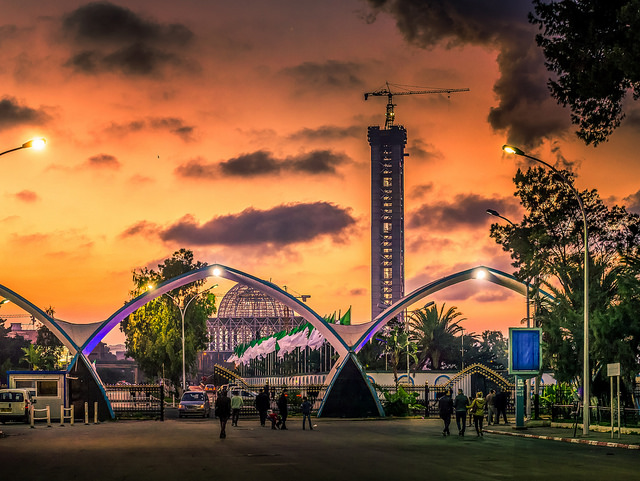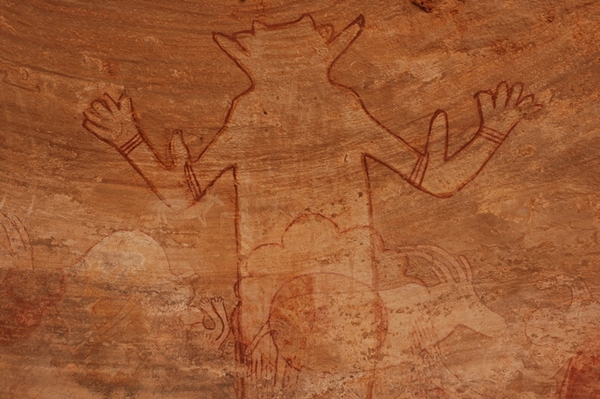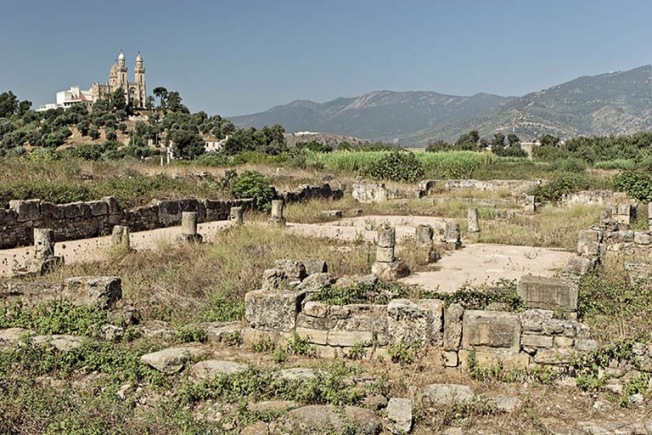Most people who know anything about Algeria are aware that is a Muslim country. It’s believed that a staggering 99% of the 40 million population are Sunni Muslims.
Algerian people often very religious and take their faith seriously in a way it’s hard for some Europeans to understand. Religion in the Western Europe is now a minority pursuit. In Algeria, religion is part of the culture. It is part of the warp and weft of everyday life, hardwired into the core of society.

New mosque being built in Algiers
But is that all that needs to be said about religion in Algeria? Not really. Algeria has in fact had a very long and varied history of religion. For example, there is a small but growing Christian community in Algeria. No one is certain how many Christians live in Algeria. Estimates vary from 20,000-100,000.
However, what is known is that Algeria has had a long and varied history of religion. In Pre-History, a wide of natural religions was followed. In the UNESCO-listed Tassili N’Ajjer world heritage site, there are over 15,000 astonishing rock paintings and carvings, some believed to be over 10,000 years old.

One of these pictures, the Great God of Sefar, shows a large godlike figure being worshipped by women.
During the Roman era, Algeria was introduced to Greek and Roman deities before Christianity became the official religion under Emperor Constantine (306-337 AD). However, this period also saw the Christian church disintegrate into rival groups, for example, those who resisted the persecution by the pagan emperors and those who submitted only to return to the faith when it was safe to do so. These divisions and others like them may be part of the reason why Christianity was so easily overcome by Islam after 670 AD.
However, for a brief and brilliant period, Algeria was the epicentre of extraordinary theological output as it was the home of the great Christian bishop and thinker Saint Augustine of Hippo (modern Annaba). Augustine’s theology is still a major influence on Christianity.

Ruined city of Hippo with Basilica of St. Augustine in the background
When the French conquered Algeria in the Nineteenth Century, the Catholic church set up four dioceses. As the country was considered to be part of Metropolitan France, the church had a close connection with the hierarchy in mainland France. At a time when a quarter of the population of Algeria (1 million out of 10 million) was of European descent, the Catholic church had power and influence. Though some saw it as an agent of colonialism, there were catholic clergy, monks and nuns who won the respect of the local population due to the practical nature of their Christian faith in areas such as education and medicine.
One such priest was Charles de Foucauld (1858-1916). He led an unhappy and chaotic young life, that included some aimless wandering around Algeria whilst in the army. But on a return visit to France, he rediscovered his faith, became a priest, and settled far out in the desert amongst the Tuareg people. He developed a great love for the local Muslim population, writing a Tuareg-French dictionary and grammar for them before being murdered by bandits. He was declared a martyr by the church. He was one of many Christians in Algeria who grew to love the country and Islam.
The war of independence that led nearly all the European settlers fleeing the country was a disaster initially for the Catholic church in Algeria. Only around 2,000 remained in the early years after French rule ended. Many catholic churches in Algeria were left deserted, their congregations having fled to France, a country many of them had never visited as they had been born and baptised in Algeria. Some of the churches found other uses, such as the Cathedral in Oran, which is now a library. Others have real architectural note, such as the beautiful church of Notre Dame de l’Afrique, still used as a place of worship in Algiers, and the modernist cathedral in the city that was built in the dying days of ‘Algérie Française’.
During the terrible ‘décennie noire’ (dark decade) of the civil war in the 1990s, the life of Christians became increasingly dangerous. The Cistercian monks of the monastery of Tibhirine south of Algiers were to lose their lives in a particularly brutal way. The monastery is in a beautiful but remote area of mountainous countryside. The local villagers adored the monks, who learned Arabic and made no attempt to convert them, simply giving them medical treatment and living a life of prayer. Unfortunately, the area was a hotbed of fundamentalist Islam, and it was not long before the monks were pressured to give medical aid to the guerrillas fighting the Algerian army. In 1996 seven monks were kidnapped and were decapitated. It has never been definitely proven who was responsible for this dreadful crime.

Monastery of Tibhirine
Since the end of the civil war, the Christian community in Algeria has been able to continue its existence. The constitution states that Islam is the religion of state, but there is freedom of conscience. However, the government in Algeria has taken a tough stance on Christian evangelistic activity. A law was passed in 2006 makes it a criminal offence for Christians to attempt to convert Muslims or possess evangelistic material. There have been reports of significant numbers of conversions amongst the Berber people of Kabylie. The Bible Society claim this could amount to up to 200,000. This claim has not been independently verified. It’s not a problem for foreigners to practice their religion in Algeria. There remain stiff penalties for any attempt to convert local people.
In recent years there have been a few worrying reports of local Christians being punished for failing to observe Ramadan. However, the situation is nevertheless better than in many other Islamic countries where Christians are routinely persecuted or murdered.
